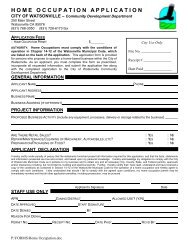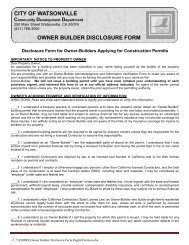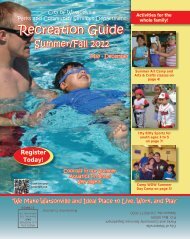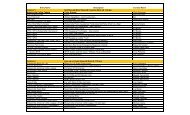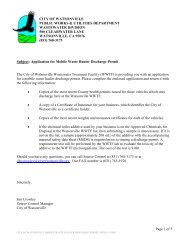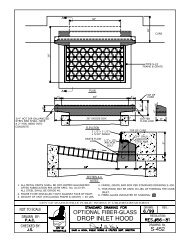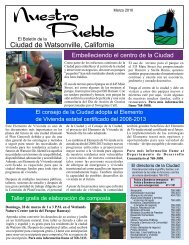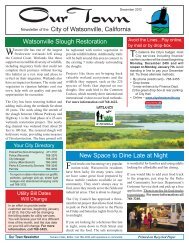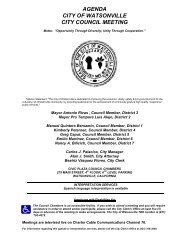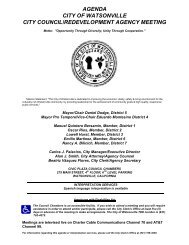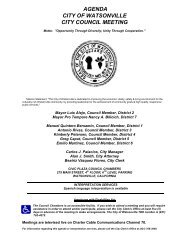Vegetation Management and Maintenance Plan - Watsonville ...
Vegetation Management and Maintenance Plan - Watsonville ...
Vegetation Management and Maintenance Plan - Watsonville ...
You also want an ePaper? Increase the reach of your titles
YUMPU automatically turns print PDFs into web optimized ePapers that Google loves.
• The ability to identify the key native plants species likely to be encountered within the<br />
VMMM project area. This could be achieved by disseminating a booklet of major native<br />
plants (as presented in Appendix B) <strong>and</strong> field training sessions.<br />
• The ability to identify areas of potential special status species/habitat, both flora <strong>and</strong><br />
fauna. A brief training session, conducted by qualified personnel, could be provided to<br />
workers to achieve a limited recognition of such habitat/species. Species of concern<br />
within the VMMM project area include Santa Cruz long-toed salam<strong>and</strong>er, California redlegged<br />
frog, <strong>and</strong> Santa Cruz tarplant.<br />
• Although field personnel often have a high degree of skill with various types of<br />
equipment, details of proper techniques should be provided to achieve maximum<br />
efficiency <strong>and</strong> success.<br />
• A discussion <strong>and</strong> presentation of the potential positive <strong>and</strong> adverse effects of various<br />
management techniques, focusing on the goals of field activities <strong>and</strong> the VMMM.<br />
• Instructions if field personnel encounter plants, animals or situations outside of their<br />
scope of training, including the proper course of action when these situations occur.<br />
General guidance should be provided to workers to limit harm to sensitive or protected<br />
habitats, including guidelines to employ that would limit the disruption of work.<br />
• Provide workers with project goals <strong>and</strong> objectives to facilitate their “buy in” with the<br />
management program. Some of the field techniques may require subtle changes in their<br />
work effort (i.e., low weed-whipping/mowing, bagging flowering heads), therefore a<br />
change of their perspective on a task may be critical for project success. Project success<br />
may increase if workers are encouraged to be knowledgeable about their work<br />
environment, have a change in outlook related to scale (slower <strong>and</strong> correct weed<br />
eradication effort often proves more efficient <strong>and</strong> effective), <strong>and</strong> to ask questions if field<br />
techniques or eradication/control goals are not clear.<br />
• Use adaptive management strategies. Field personnel may have useful <strong>and</strong> efficient ideas<br />
<strong>and</strong> methods for doing a given task. Field supervisors should be encouraged to consider<br />
new ideas <strong>and</strong> potential improvements. “I may not use an idea, but I will listen <strong>and</strong><br />
considered it”, is a concept that not only increases effectiveness but also increases “buy<br />
in” by field personnel.<br />
3.1.2 Grubbing<br />
Within the VMMM project area, grubbing, both with tools <strong>and</strong> by h<strong>and</strong>, is a suitable treatment<br />
for infestations of cape ivy, English ivy, thistles (Italian thistle, slender-flowered thistle, bull<br />
thistle), bristly ox-tongue, wild radish <strong>and</strong> most other invasive weeds found in isolated small<br />
patches. Grubbing is often used during the Bradley Method. The Bradley Method is a technique<br />
where invasive plants are completely removed around the perimeter of desirable, existing native<br />
plants to create noncompetitive growth patches for the native plants.<br />
Additionally, h<strong>and</strong> grubbing may be used to create controllable perimeters around large patches<br />
of poison hemlock <strong>and</strong> Himalaya berry. In some cases, all biomass created by grubbing should be<br />
bagged <strong>and</strong> removed for proper disposal. <strong>Plan</strong>ts that should be carefully bagged <strong>and</strong> removed for<br />
disposal include species that re-sprout from spreading rhizomes or stems, such as Cape ivy,<br />
English ivy, Kikuyu grass, <strong>and</strong> Harding grass. Table 4 provides specific details for grubbing<br />
individual plant species.<br />
Grubbing should be followed by revegetation with appropriate native plants. Appropriate erosion<br />
control practices <strong>and</strong> techniques should also be implemented prior to grubbing, <strong>and</strong> applied as<br />
needed during or immediately after the work is completed.<br />
<strong>Vegetation</strong> <strong>Management</strong> <strong>and</strong> <strong>Maintenance</strong> Manual<br />
Draft 15 July 27, 2007




